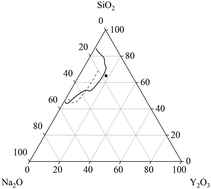Comparative study of the crystallization behavior within the Na2O–Y2O3–ZrO2–SiO2 system during heating and cooling
Abstract
Phase formation in glasses from the system Na2O–Y2O3–SiO2 with different concentrations of ZrO2 were studied concerning phase formation and crystallization behavior. The compositions were near the stoichiometry of NaYSi2O6. A comparison of microstructure and phase content after instant crystallization during slow cooling and after subsequent thermal annealing is given. The phases as well as the microstructure differ depending on thermal history. During cooling, predominantly a phase with apatite structure (NaY9Si6O26) precipitates and the residual glassy phase is enriched in ZrO2. The composition of the glassy phase was quantified and an enrichment of ZrO2 of slightly above five mol% was measured. ZrO2 concentrations >5 mol% lead to the precipitation of Y2O3 enriched ZrO2. A fast cooling of the melt results in glass formation without instant crystallization. Subsequent heating at temperatures below 1000 °C leads to the precipitation of an unknown phase whereas at higher temperatures NaYSi2O6 crystallizes. Two-step heating in terms of nucleation and crystal growth were performed and small ZrO2-particles have been formed homogenously within the sample volume. Those particles do not trigger volume crystallization within the glasses and surface crystallization is the predominant crystallization mechanism.

- This article is part of the themed collection: Open Access in CrystEngComm


 Please wait while we load your content...
Please wait while we load your content...